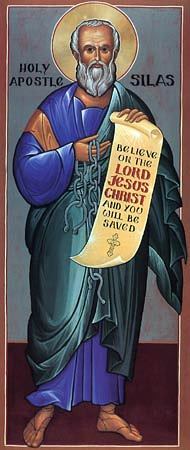Silas
This article uses secondary sources that critically analyze them. (December 2022) ) |
Silas | |
|---|---|
 | |
| Apostle, Disciple, Missionary, Bishop, and Martyr | |
| Died | 65–100 AD Macedonia |
| Venerated in |
|
| Feast |
|
Christian Martyrdom | |
Silas or Silvanus (
Name and etymologies
Silas is traditionally assumed to be the same as the Silvanus mentioned in four epistles. Some translations, including the New International Version, call him "Silas" in the epistles. Paul, Silas, and Timothy are listed as co-authors of the two New Testament letters to the Thessalonians, though the authorship is disputed. The Second Epistle to the Corinthians mentions Silas as having preached with Paul and Timothy to the church in Corinth (1:19), and the First Epistle of Peter describes Silas as a "faithful brother" (5:12).
There is some disagreement over the original or "proper" form of his name: "Silas", "Silvanus", "Seila", and "Saul" seem to be treated at the time as equivalent versions of the same name in different languages, and it is not clear which is the original name of "Silas", and which is a translation or equivalent nickname, or whether some references are to different persons with equivalent names. He is consistently called "Silas" in the
Biblical narrative
Silas is first mentioned in Acts 15:22, where he and
According to Acts 17–18, Silas and Timothy travelled with Paul from Philippi to
These events can be dated to around AD 50: the reference in Acts 18:12 to Proconsul
He appears in the salutation of 1 and 2 Thessalonians, and is referred to in 2 Corinthians 1:19. This is as expected, as we read of his involvement in Paul's mission when these cities were visited. He also appears in the conclusion of 1 Peter at 5:12, and is perhaps the amanuensis. Peter says he regards Silas as "a faithful brother".
Mysticism
Anne Catherine Emmerich recounts in her visions that Silas' original name was Sela, and that he was one of the three "secret disciples," along with Hermas, who had later accompanied Jesus on his trip to the Three Kings' homeland near Ur, and thence to Heliopolis, and whose parents had come with the caravan of the Three Kings.[7]
Veneration
Saint Silas is celebrated in the
See also
- Paul the Apostle
- Agabus
- Barnabas
- Manahen
- Teachings of Silvanus: an apocryphal text from the Nag Hammadi Library[9] that is attributed to Silvanus/Silas.
- Churches named after St Silas
References
- ^ "Notes on 1 Peter". Archived from the original on 2015-10-03. Retrieved 2012-05-20.
- ^ a b
ISBN 0-521-78155-8– via Google Books.
- ^
Fitzmyer, Joseph J., ed. (1998). The Anchor Bible: The Acts of the Apostles. New York: Doubleday. p. 564. ISBN 0-385-49020-8– via Internet Archive.
- ^ The Holy Disciples from the Seventy
- ^ Acts 18:5
- ISBN 978-0-19-280290-3.
- ^ Emmerich, Anne Catherine (1914). "vol. 3". In Brentano, Clement; Schmöger, Carl E. (eds.). The Life of Jesus Christ and Biblical Revelations. Rockford, IL: Tan. p. 492. Retrieved 24 October 2022.
- ^ "Holy Women, Holy Men Celebrating the Saints" (PDF).
- ^ "Nag Hammadi Library". gnosis.org. Retrieved 2019-03-25.
